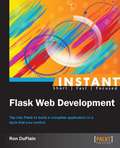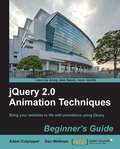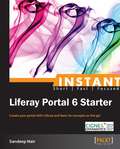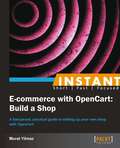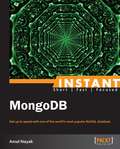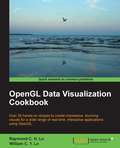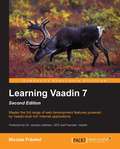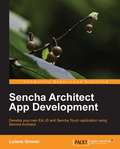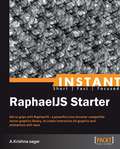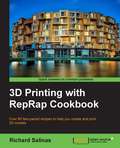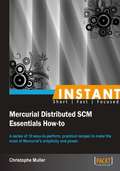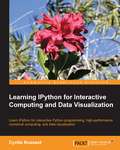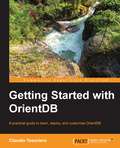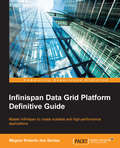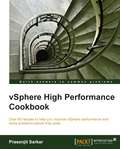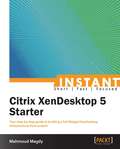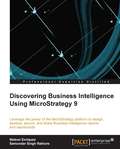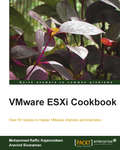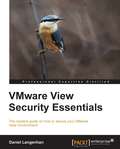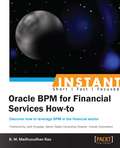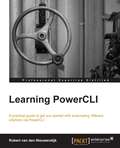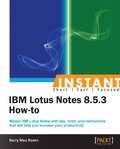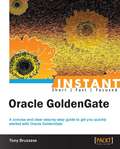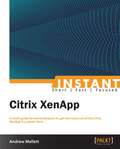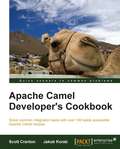- Table View
- List View
Instant Flask Web Development
by Ron DuplainFilled with practical, step-by-step instructions and clear explanations for the most important and useful tasks. The book uses a bottom-up approach to help you build applications, and is full of step-by-step instructions and practical examples to help you improve your knowledge.Instant Flask Web Development is for developers who are new to web programming, or are familiar with web programming but new to Flask. This book gives you a head start if you have some beginner experience with Python and HTML, or are willing to learn.
jQuery 2.0 Animation Techniques Beginner's Guide
by Dan Wellman Adam CulpepperThis book is a guide to help you create attractive web page animations using jQuery. Written in a friendly and engaging approach this book is designed to be placed alongside your computer as a mentor.If you are a web designer or a frontend developer or if you want to learn how to animate the user interface of your web applications with jQuery, this book is for you. Experience with jQuery or Javascript would be helpful but solid knowledge base of HTML and CSS is assumed.
Instant Liferay Portal 6 Starter
by Sandeep NairGet to grips with a new technology, understand what it is and what it can do for you, and then get to work with the most important features and tasks. A simple Starter approach towards understanding significant areas of portals such as content management, document management, and collaboration. It also provides an overview of Liferay concepts and terminologies.Instant Liferay Portal 6 Starter is great for new users who want to know what Liferay is all about. It will quickly give them an overview about Liferay Portal and its features. It is also good for those who want to analyze whether Liferay is fit for their requirements and are interested in what unique features Liferay can offer.
Instant E-commerce with OpenCart: Build a Shop How-to
by Murat YilmazFilled with practical, step-by-step instructions and clear explanations for the most important and useful tasks. "Instant E-Commerce with OpenCart: Build a Shop How-to" is written in a friendly, helpful style which takes you through several distinct recipes, all geared to getting you started with OpenCart and selling your products as quickly and as efficiently as possible. The only thing you need to bring to the table is a desire to sell your products online."Instant E-Commerce with OpenCart: Build a Shop How-to" is for anyone who wants to learn how to quickly set up, configure, and manage an online shop with OpenCart. Regardless of whether you are technically skilled or not, this book will show you how to create a fully functioning e-commerce solution.
Instant MongoDB
by Amol NayakGet to grips with a new technology, understand what it is and what it can do for you, and then get to work with the most important features and tasks. MongoDB Starter is a fast and practical guide designed to help you start developing high-performance and scalable applications using MongoDB.MongoDB Starter is ideal for developers who are new to MongoDB and who need a no-nonsense guide on how to start working with it. No knowledge of MongoDB is required to follow this book, but some knowledge of C++ would be helpful.
OpenGL Data Visualization Cookbook
by Raymond C. H. Lo William C. Y. LoOver 40 hands-on recipes to create impressive, stunning visuals for a wide range of real-time, interactive applications using OpenGL About This Book * Get acquainted with a set of fundamental OpenGL primitives and concepts that enable users to create stunning visuals of arbitrarily complex 2D and 3D datasets for many common applications * Explore interactive, real-time visualization of large 2D and 3D datasets or models, including the use of more advanced techniques such as stereoscopic 3D rendering. * Create stunning visuals on the latest platforms including mobile phones and state-of-the-art wearable computing devices Who This Book Is For This book is aimed at anyone interested in creating impressive data visualization tools using modern graphics hardware. Whether you are a developer, engineer, or scientist, if you are interested in exploring the power of OpenGL for data visualization, this book is for you. While familiarity with C/C++ is recommended, no previous experience with OpenGL is assumed. What You Will Learn * Install, compile, and integrate the OpenGL pipeline into your own project * Create interactive applications using GLFW and handle user inputs with callback functions * Use OpenGL primitives and features in the OpenGL Shading Language (GLSL) * Render complex 3D volumetric data with techniques such as data slicers and multiple viewpoint projection * Implement a hardware-accelerated data visualizer, heat map generator, point cloud rendering, perspective rendering, and alpha blending * Process images or video sources with texture mapping and custom fragment shader programs for image resizing and wrapping * Develop video see-through augmented reality applications with OpenGL * Visualize 3D models using meshes and surfaces with dynamic lighting In Detail OpenGL is a great multi-platform, cross-language, and hardware-accelerated graphics interface for visualizing large 2D and 3D datasets. Data visualization has become increasingly challenging using conventional approaches as datasets become larger and larger, especially with the Big Data evolution. From a mobile device to a sophisticated high-performance computing cluster, OpenGL libraries provide developers with an easy-to-use interface to create stunning visuals in 3D in real time for a wide range of interactive applications. This book provides easy-to-follow, hands-on tutorials to create appealing OpenGL-based visualization tools with minimal development time. We will first illustrate how to quickly set up the development environment in Windows, Mac, and Linux. Next, we will demonstrate how to visualize data for a wide range of applications using OpenGL, starting from simple 2D datasets to increasingly complex 3D datasets with more advanced techniques. Each chapter addresses different visualization problems encountered in real life and introduces the relevant OpenGL features and libraries in a modular fashion. By the end of this book, you will be equipped with the essential skills to develop a wide range of impressive OpenGL-based applications for your unique data visualization needs, on platforms ranging from conventional computers to the latest mobile/wearable devices. Style and approach This is an easy-to-follow, comprehensive Cookbook showing readers how to create an application with real-time, interactive data visualization in stereoscopic 3D. Each topic is explained in a step-by-step format. A range of hot topics is included, including data visualization on mobile and wearable platforms."
Learning Vaadin 7: Second Edition
by Nicolas FrankelThis book begins with a tutorial on Vaadin 7, followed by a process of planning, analyzing, building, and deploying a fully functional RIA while covering troubleshooting details along the way, making it an invaluable resource for answers to all your Vaadin questions.If you are a Java developer with some experience in development either on JSP/Servlet or on Swing, and want to enter the world of rich Internet applications, then this technology and book is ideal for you. Learning Vaadin will be perfect as your next step towards building eye-catching, dynamic web applications on a Java-based platform.
Sencha Architect App Development
by Loiane GronerA standard tutorial-based approach for using Sencha Architect to develop applications in Ext JS and Sencha Touch.Sencha Architect App Development is for Ext JS and Sencha Touch developers that are looking to improve their productivity by using Sencha Architect for app development. Basic knowledge of Ext JS and Sencha Touch is required.
Instant RaphaelJS Starter
by A. Krishna SagarGet to grips with a new technology, understand what it is and what it can do for you, and then get to work with the most important features and tasks. Starter GuideThis book is great for developers new to Vector graphics in browsers (SVG and VML), and who are looking to get a good grounding in how to use Raphael JS to create imageless and fast loading interactive drawings and shapes, in a web browser. It's assumed that you will have some experience in HTML JavaScript or jQuery already.
3D Printing with RepRap Cookbook
by Richard SalinasA systematic guide consisting of over 100 recipes which focus on helping you understand the process of 3D printing using RepRap machines. The book aims at providing professionals with a series of working recipes to help make their fuzzy notions into real, saleable projects/objects using 3D printing technology. This book is for novice designers and artists who own a RepRap-based 3D printer, have fundamental knowledge of its working, and who desire to gain better mastery of the printing process. For the more experienced user, it will provide a handy visual resource, with side-by-side comparisons of the two most popular slicers, Skeinforge and Slic3r. A basic understanding of designing and modeling principles and elementary knowledge of digital modeling would be a plus.
Instant Mercurial Distributed SCM Essentials How-to
by Christophe MullerFilled with practical, step-by-step instructions and clear explanations for the most important and useful tasks. This book has a simplified, recipe-based approach, which shows the essential features of Mercurial SCM for software configuration engineers/programmers using Mercurial or another version control system of a similar kind.Instant Mercurial SCM Essentials How-to is aimed at software developers already familiar with version control but new to the Mercurial open source DVCS, who want to master both the basics and some very advanced features of the tool. You are expected to be familiar at either working with the console in Windows, or the Unix command line in Linux or Mac OS X, as the examples are command-line based.
Learning IPython for Interactive Computing and Data Visualization
by Cyrille RossantA practical hands-on guide which focuses on interactive programming, numerical computing, and data analysis with IPython.This book is for Python developers who use Python as a scripting language or for software development, and are interested in learning IPython for increasing their productivity during interactive sessions in the console. Knowledge of Python is required, whereas no knowledge of IPython is necessary.
Getting Started with OrientDB
by Claudio TesorieroA standard tutorial aimed at making you an OrientDB expert, through the use of practical examples, explained in a step-by-step format.Getting Started with OrientDB 1.3.0 is great for database designers, developers, and systems engineers. It is assumed that you are familiar with NoSQL concepts, Java, and networking principles.
Infinispan Data Grid Platform Definitive Guide
by Wagner Roberto SantosThis practical guide is intended for those who want to learn how to build extremely scalable applications. This book is easy to read and is aimed at Java enterprise developers with a solid knowledge of Java. However, no previous coding experience with Infinispan is required.
vSphere High Performance Cookbook
by Prasenjit SarkarvSphere High Performance Cookbook is written in a practical, helpful style with numerous recipes focusing on answering and providing solutions to common, and not-so common, performance issues and problems.The book is primarily written for technical professionals with system administration skills and some VMware experience who wish to learn about advanced optimization and the configuration features and functions for vSphere 5.1.
Instant Citrix XenDesktop 5 Starter
by Mahmoud MagdyGet to grips with a new technology, understand what it is and what it can do for you, and then get to work with the most important features and tasks. This easy-to-follow, hands-on guide shows you how to implement desktop virtualization with real life cases and step-by-step instructions. It is a tutorial with step-by-step instructions and adequate screenshots for the installation and administration of Citrix XenDesktop.If you are new to XenDesktop or are looking to build your skills in desktop virtualization, this is your step-by-step guide to learning Citrix XenDesktop. For those architects and designers experienced in XenDesktop infrastructure implementation this book aims to be a quick reference guide with notes and reminders for their day-to-day tasks.
Discovering Business Intelligence Using MicroStrategy 9
by Samundar Singh Rathore Nelson EnriquezThis is a step-by-step tutorial that covers the basics of working with the MicroStrategy platform.If you are a BI developer who would like to use MicroStrategy to build BI apps, this book is ideal for you. This book is also for mid-management executives who need to analyze data and Excel files that are too complicated to manage. A basic concept of BI is assumed.
VMware ESXi Cookbook
by Mohammed Raffic Kajamoideen Aravind Sivaraman"VMware ESXi 5.1" is written in a Cookbook style, learn through practical real world recipes and examples. "VMware ESXi 5.1 Cookbook" is written for technical professionals with system administration skills and foundation knowledge of virtualization and who need to learn about the installation, configuration, and administration of vSphere 5.1. Essential virtualization and ESX or ESXi knowledge is advantageous.
VMware View Security Essentials
by Daniel LangenhanA practical and fast-paced guide that gives you all the information you need to secure your virtual environment.This book is a "how-to" for the novice, a "reference guide" for the advanced user, and a "go to" for the experienced user in all the aspects of VMware View desktop virtualization security.
Instant Oracle BPM for Financial Services How-to
by B. M. RaoFilled with practical, step-by-step instructions and clear explanations for the most important and useful tasks. This book is a practical Packt How-to guide that is designed to provide targeted information for experienced BPM professionals in the financial sector.This book will be ideal as a pocket guide for people working with BPM for financial services. It is a short reference for financial analysts, business process owners, process participants, business process developers, and SOA and BPM architects and developers.
Learning PowerCLI
by Robert Van Nieuwendijk"Learning PowerCLI" is written in a friendly and practical style with a focus on getting you started and automating daily tasks quickly and efficiently. If you manage or administrate a vSphere environment, and want to make that easier and more efficient, then this book is for you! This book is ideal for you if you want to learn how to automate your VMware vSphere infrastructure, by getting the most out of PowerCLI. It's assumed that you have some experience in administrating a VMware vSphere environment. Knowledge of Microsoft's Windows PowerShell is not a prerequisite.
Instant IBM Lotus Notes 8.5.3 How-to
by Barry Max RosenGet to grips with a new technology, understand what it is and what it can do for you, and then get to work with the most important features and tasks.A Packt Instant How-to guide, which provides a quick and easy way to get started with IBM Lotus Notes 8.5.3.If you are brand new to Lotus Notes, a seasoned professional, or you are coming from Microsoft Outlook, this book will enable you to work smarter not harder in Lotus Notes 8.5.3.
Instant Oracle GoldenGate
by Tony BruzzeseFilled with practical, step-by-step instructions and clear explanations for the most important and useful tasks. Get the job done and learn as you go. A how-To book with practical recipes accompanied with rich screenshots for easy comprehension.This is a Packt Instant How-to guide, which provides concise and clear recipes for performing the core task of replication using Oracle GoldenGate.The book is aimed at DBAs from any of popular RDBMS systems such as Oracle, SQL Server, Teradata, Sybase, and so on. The level of detail provides quick applicability to beginners and a handy review for more advanced administrators.
Instant Citrix XenApp
by Andrew MallettGet to grips with a new technology, understand what it is and what it can do for you, and then get to work with the most important features and tasks. This book is a great tool to quickly learn and explore the features offered by XenApp 6.5.Windows system administrators who want a quick lesson on how to install and configure XenApp.
Apache Camel Developer's Cookbook
by Scott Cranton Jakub KorabThis book is written in a Cookbook style with short recipes showing developers how to effectively implement EIP without breaking everything in the process. It is concise and to the point, and it helps developers get their data flowing between different components without the need to read through page upon page of theory, while also enabling the reader to learn how to create exciting new projects.Camel Enterprise Integration Cookbook is intended for developers who have some familiarity with Apache Camel and who want a quick lookup reference to practical, proven tips on how to perform common tasks. Every recipe also includes a summary and reference pointers for more details that make it easy for you to get a deeper understanding of the Apache Camel capabilities that you will use day to day.
